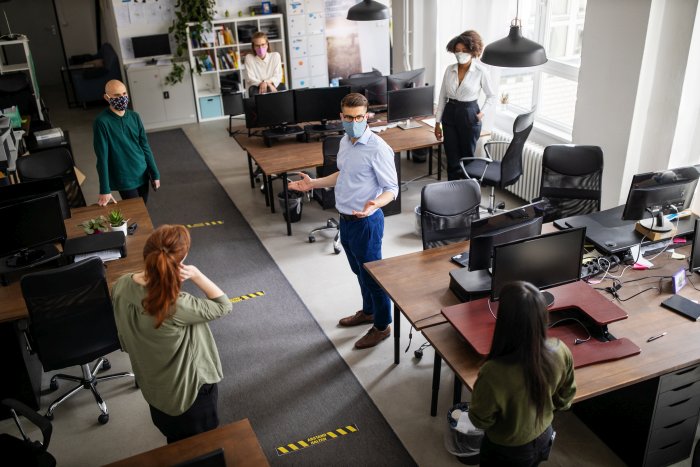
Over the past twelve months, the pandemic has demanded of every organisation and every worker to continuously adapt. The use of technology has become essential to the survival of most businesses. Office workers, the majority of which still work remotely, have adopted new technology tools to keep them connected to colleagues and customers, and maintain some form of business-as-usual.
Having led my own teams in Southern Africa through the ongoing pandemic crisis, I have learned some valuable lessons that I gladly share with the hope that it will help others through the difficult period we are all collectively experiencing.
Learning #1 – Immediate innovation was essential to organisations surviving the initial impact
When the first lockdowns were announced, some sectors could adapt by enabling office workers to perform their duties remotely. Those organisations that had invested in digital transformation could more easily enable remote work. Everyone else had to undergo a process of rapid innovation to keep their business going. These investments are likely to play a vital role in the ability of organisations to continue to adapt to a very volatile and uncertain operating environment.
Learning #2 – But long-term innovation cannot be left for later
However, organisations cannot only focus on short-term productivity gains: there is a pressing need to build capabilities that can help businesses succeed well into the future too. It is vital that organisations develop clear plans for how new technologies such as 5G, IoT and artificial intelligence will support their business, and build suitable capabilities.
Learning #3 – Organisations need purpose-based leadership now more than ever
The pandemic has highlighted and – in many cases, worsened – some of the prevailing inequalities in our society. Any effort to build back and recover from the devastating economic and social impact of the past year will require a concerted effort to close the equality gap. For organisational leaders, this means taking responsibility for driving an inclusive economic recovery agenda, which requires them to look beyond only short term profit to longer-term socio-economic value drivers, such as skills development, enterprise development and innovation.
Learning #4 – All industries are interconnected
The impact of the pandemic has created ripple effects across every industry. For example, the disruption to China’s manufacturing industry had directly affected global supply chains. As the levels of manufacturing activity in China fell, organisations elsewhere in the world that depend on parts and components from Chinese manufacturers could not develop their own products, which in turn has ripple effects further down the supply chain.
Learning #5 – The supply chain is the lifeblood of our economy – and our vaccine response
The distribution and administration of vaccines at the scale demanded by the COVID-19 pandemic is a monumental challenge that has put immense pressure on global supply chains. Any disruption in the supply chain could prevent the delivery of vaccines to communities that need it most, which may cost lives and push out the prospect of achieving herd immunity. Continuous innovation is required to strengthen global supply chains, especially as countries embark on their vaccination programmes.
Learning #6 – Connectivity is critical
If the past year revealed one truth, it is that internet connectivity is absolutely essential to life during the pandemic. Without it, remote workers could not work, school kids could not learn and families and friends would find it nearly impossible to stay in touch. The rollout of 5G in South Africa’s urban centres is likely to be one of the most significant technology events of 2021, and could transform remote work, home entertainment, and online learning.
Learning #7 – SMEs are key to our recovery – but they need access to tech
According to the World Bank, SMEs in emerging markets are responsible for creating as much as 70% of formal employment, and are critical to driving inclusive economic growth. As South Africa rebuilds its economy, SMEs in formal and informal markets will be essential to job creation and GDP growth. SMEs that have built technology capabilities would have found it far easier to adapt to the past year’s challenges. This year, technology providers are likely to enhance their offerings to SMEs to support this critical sector of the economy.
Learning #8 – Work-from-home works (and it’s going nowhere)
One of the most visible and widespread changes of the past year is the incredible growth in remote working. Organisations that were previously hesitant to allow employees to work from home would have had no other option during lockdown. Since the early days, many organisations have seen tremendous benefits to the remote work model, as employees remain productive but with the added benefit of not having to commute to the office during rush hour traffic.
Learning #9 – New ways are needed to manage and motivate remote workers
Organisations will however need new tools for measuring, managing and motivating the performance and productivity of remote workers. New management styles will need to emerge to ensure remote teams operate optimally. Organisations are likely to develop more outcomes-based KPIs, conduct more regular checkpoints, and provide greater flexibility to accommodate working times and styles.
Learning #10 – Digital skills are vital
The sudden switch to remote work and virtual teaching has had a surprising upside: many digital skills development initiatives have actually seen an increase in uptake and impact since the start of the pandemic. SAP’s Young Professional Program, for example, was able to expand access to candidates in new countries and regions following a switch to an all-virtual model. The flagship SAP Africa Code Week initiative also expanded access to all African countries for the first time, enabling youth from even some of the more remote regions to learn critical digital skills for the first time.
Learning #11 – Our relationship with technology will only deepen
As the cost of specialised machine learning computer chips continue to fall and 5G connectivity spreads, the world is rapidly approaching a time when every device is intelligent. The growing adoption of AI technologies will enable humans to partner with AI in every aspect of their work, with AI algorithms becoming entrenched in everyday business operations.
Learning #12 – Sustainability is critical to our recovery – and our future
The pandemic has been a warning sign that our current relationship with the natural world is unsustainable. Organisations and governments will likely prioritise investment into new, clean technologies to ensure minimal harm to the environment. We are also likely to see a renewed drive to achieve the UN Sustainable Development Goals, with a focus on reducing reliance on harmful products, practices and processes.
Visit the SAP News Center. Follow SAP on Twitter at @SAPNews.
About SAP
SAP’s strategy is to help every business run as an intelligent enterprise. As a market leader in enterprise application software, we help companies of all sizes and in all industries run at their best: 77% of the world’s transaction revenue touches an SAP® system. Our machine learning, Internet of Things (IoT), and advanced analytics technologies help turn customers’ businesses into intelligent enterprises. SAP helps give people and organizations deep business insight and fosters collaboration that helps them stay ahead of their competition. We simplify technology for companies so they can consume our software the way they want – without disruption. Our end-to-end suite of applications and services enables business and public customers across 25 industries globally to operate profitably, adapt continuously, and make a difference. With a global network of customers, partners, employees, and thought leaders, SAP helps the world run better and improve people’s lives. For more information, visit www.sap.com.
